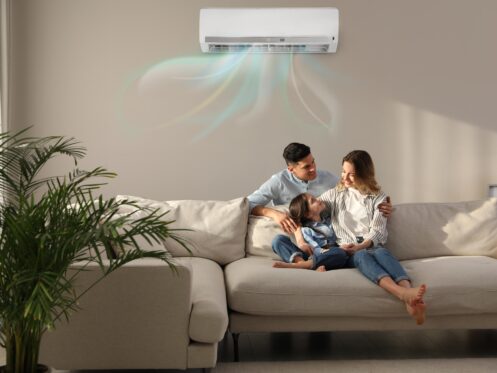When the Florida heat is cranked up and humidity clings like a second skin, your air conditioning system is survival gear. But when it’s time for a new cooling system, the age-old question pops up: Ductless mini-split or central AC? Both can keep your home feeling like a breezy paradise, but they do it in very different ways.
Choosing the right system means taking into account your home’s layout, your energy bills, your comfort preferences, and, yes, your budget. Let’s dive into what makes each system different, where each one shines, and how to decide which cooling powerhouse is right for your Florida home.
Why It Matters in Florida’s Heat & Humidity
Florida weather doesn’t mess around. Between the relentless sun and the thick humidity, your AC works overtime for most of the year. The right system can make or break your comfort level and your energy bills. Mini-splits and central AC units both offer relief, but their ability to handle Florida’s unique climate varies more than you might think.
Humidity control is the unsung hero of indoor comfort here. Central air systems tend to be strong dehumidifiers because they circulate large volumes of air through return ducts. Ductless mini-splits, on the other hand, excel at localized comfort, which means you can cool only the spaces you actually use. That zoning advantage helps reduce wasted energy while still keeping your home crisp and comfortable, even when the humidity feels like soup.
How Central AC & Ductless Mini-Splits Actually Work
A central air conditioner uses a single outdoor unit connected to the indoor air handler that’s shared with your furnace. Air moves through a network of ducts, pushing cool air to each room through vents. It’s efficient for whole-home cooling if your ducts are clean and sealed properly.
A ductless mini-split, as the name suggests, skips the ducts altogether. Instead, it uses an outdoor compressor connected to one or more indoor air handlers mounted on walls or ceilings. Each handler cools its specific zone, so you can control the temperature in individual rooms independently. It’s a more flexible setup, perfect for older homes without ductwork, room additions, or spaces that never seem to stay the right temperature.
Comparing Upfront Costs
Let’s talk dollars and sense. Central AC systems usually cost less upfront if your home already has ductwork in good condition. Installation can range from moderate to expensive, depending on the system’s size and Seasonal Energy Efficiency Ratio (SEER), but you’re essentially paying for one big system that cools the entire house.
Ductless mini-splits, on the other hand, typically come with higher installation costs per room or zone. Each indoor unit requires its own connection to the outdoor compressor, which can increase labor and materials. However, they can be far more cost-effective over time, especially if you only need to cool certain areas. Think of it like paying more now to save more later, especially on those summer electricity bills.
Performance Under Load
Here’s where Florida’s sweltering summers really test your system. Central AC units are designed for consistent, even cooling throughout the entire home. Once the thermostat hits your set temperature, the system cycles on and off to maintain it. The catch? Each time it cycles, it draws a burst of power, which can drive up energy use.
Ductless AC units work differently. They use inverter technology, meaning they don’t shut off completely once your desired temperature is reached. Instead, they modulate output by running continuously but at lower speeds when less cooling is needed. That steady performance helps maintain comfort without the rollercoaster of temperature fluctuations, making them more energy-efficient, especially during mild days or overnight.
Comfort, Zoning & Control
If you’ve ever had family members battle over the thermostat, mini-splits might just bring peace to your household. Each indoor unit operates independently, so one person can chill their bedroom Arctic-style while another keeps the living room cozy. This zoning capability is a major selling point for Florida homeowners who spend more time in certain rooms than others.
Central AC systems, while powerful, control the temperature from one central thermostat, meaning every room gets the same treatment whether it needs it or not. That can lead to hot spots, cold corners, and family thermostat wars. However, adding smart vents or a zoned central system can bridge that gap if you’re looking for more control.
Indoor Air Quality, Filtration & Health Impacts
With all that humidity, mold and allergens can creep into your indoor air. Indoor air quality is a huge factor in deciding between these systems. Central AC units often integrate high-quality filtration systems that trap dust, pollen, and other airborne particles as air moves through the ductwork. However, if those ducts aren’t cleaned or sealed properly, they can also harbor dust, bacteria, and mold.
Ductless mini-splits, by contrast, avoid duct-related contamination altogether. Each indoor unit has its own multi-stage air filters designed to catch fine particles and purify air locally. That’s a huge plus for allergy sufferers or anyone with respiratory concerns. Maintenance is as simple as washing the filters every few weeks, which is a small trade-off for cleaner, fresher air all year round.
Reliability, Maintenance & Lifetime Costs
Central AC systems are generally durable workhorses, especially when professionally maintained. They require annual tune-ups and occasional duct inspections to prevent airflow issues or leaks. When something goes wrong, like a refrigerant leak or compressor failure, the repairs can be costly, but replacement parts are widely available.
Ductless systems, though newer on the market, have earned a reputation for reliability. Because they operate on smaller loads and don’t depend on ducts, there’s less wear and tear overall. Routine air filter cleaning and coil maintenance are simple and can often be done without major service calls. While each indoor unit can require its own repair over time, the modular design means one malfunctioning zone won’t take down your entire system.
What Type of Home Suits Each System
Every Florida home has its quirks, and the right system depends on how yours is built and how you live. Central AC fits best in homes that already have ductwork or large spaces that benefit from consistent cooling throughout. It’s also ideal for families who prefer one simple system to manage the whole home.
Ductless mini-splits, meanwhile, are perfect for homes without existing ducts, remodeled spaces, guest suites, sunrooms, or older properties where adding ductwork would be a nightmare. They’re also fantastic for homeowners who want to cut back on energy use without sacrificing comfort. If you work from home and only use a few rooms during the day, a ductless system could be your new best friend.
Upgrade Your Cooling Power With Erica’s
If your current AC system struggles to keep up with Florida’s wild weather swings, it might be time for an upgrade. At Erica’s Plumbing, Air Conditioning & Restoration, our team is passionate about helping homeowners stay cool, comfortable, and energy-efficient without the stress. Whether you’re curious about switching to a ductless mini-split or upgrading your central AC, we’ll walk you through every option so you can make the best choice for your home and budget.
Our certified technicians provide expert installation, top-tier maintenance, and quick repairs backed by friendly service and Florida know-how. Don’t sweat through another season of uneven temperatures and rising energy bills. Schedule your AC service in Palm Beach and Broward counties with Erica’s today and let’s get your home ready for year-round comfort!

